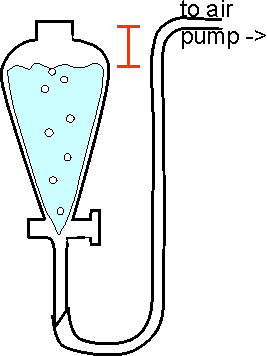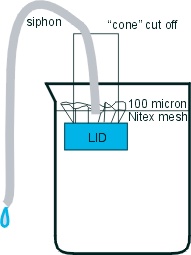Introduction:
Sea urchin embryos are like all animals, they need oxygen to grow. If water or seawater sits in a still beaker, the oxygen is depleted from the water at the lower depths. In fact you only get good oxygen penetration to about 1 cm. Below 1 cm oxygen levels are less than ideal. You could raise the embryos in dishes with the water level at 1 cm, but you are likely to suffer from evaporation, removing too much of the water and raising the osmolarity to a lethal level. The way to get around this is to set the water into motion. If it is too fast, the embryos will be broken up. If too slow, then not enough turn over of oxygen occurs.
A second consideration is cleanliness. A dirty culture is a short lived one.
Stirrers:
The best ones to use for the classroom are DC gearhead motors that can be run off of batteries. Batteries are safer than the alternative of using 110AC clock motors around seawater, and if we get them surplus, they are cheaper also (see Suppliers).
A motor dipped in seawater will be ruined. So, what we do is put them on a "shelf" made of Styrofoam packing material, along with the battery and a switch to stop the motor when no longer needed. An all plastic dropping pipette (see Suppliers) is cut up to form the paddle. First you cut the bulb off, then slit the bulb length wise on one side. Open up the bulb and make two slits in the middle for the left over "stem" to slide into and attach to the drive shaft of the motor. See illustration:

 |
Since the motors are not always available, a setup used to culture brine shrimp may also work. Pet stores carry adapters for 2 liter soda bottles, or you can do the same using a separatory funnel from your chemistry dept. Make sure the air line is ABOVE the level of water in the funnel to prevent water getting into the air pump when off or during a power failure. Air volume should be lower than for brine shrimp. Use the minimum to keep everything moving. Too much air will "bump" the embryos too much. |
Cleanliness:
- past the pluteus stage, keep number of embryos in the seawater low. We have found that a 0.01% or about 300 embryos / ml of seawater works well.
- remove dead ones from the bottom of the beaker regularly. Dead embros = bacteria = everything dying!
- Do not overfeed! Too much food = bacteria = everything dying!
- replace seawater with filtered seawater as needed. this may be as often as once per day.
- as a last resort, you can add antibiotics to the seawater. See our page on storing gametes and use the various "egg" antibiotic methods formulas.
- Do not use autoclaved seawater for the embryos. Something happens to the seawater making the embryos clump and subsequently die. You can sterilize the dry glassware this way though.
Changing seawater:
We put a 100 micron Nitex mesh (see Suppliers) over the capped end of a 50ml plastic centrifuge tube and siphon the seawater gently out of the beaker (the center of the cap has be cut out). This takes some practice to avoid hurting the embryos.

We are talking to suppliers about putting all of this together as a "kit", but we are not there yet.
